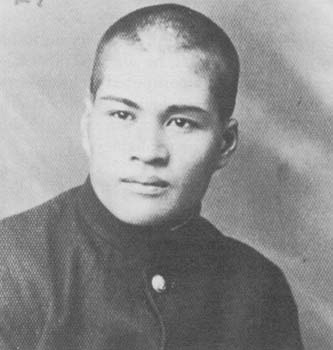Japan

Lieutenant Yoshi-o Fukui
Japan

Lieutenant Yoshi-o Fukui

Fukui was born in Kagawa Prefecture on 10 April 1913.
He enlisted at the Sasebo Barracks in 1931, initially serving as a maintenance man.
He graduated from the 26th Pilot Training Class in March 1935 and became a fighter pilot.
After serving in both the Omura and Kanoya Kokutais, Fukui was posted to the Ryujo at the start of the China Incident. This carrier was at the time equipped with Nakajima A2N fighters.
The light aircraft carrier Hosho was posted together with the carrier Ryujo to 1st Carrier Division of the 3rd Fleet, leaving the port of Sasebo on 12 August. Arriving in the Ma-an-shan Islands area, they started supporting land operations beginning on 16 August. During this period, both Kaga and Ryujo groups had opportunity to engage in aerial battles.
At 07:00 on 22 August Captain Wang Tien-Hsiang led 18 Hawk IIIs (including five aircraft from the 5th PG) to attack Japanese surface forces in the Liu Ho area near Shanghai.
Four A2Ns under the command of Lieutenant (junior grade) Tadashi Kaneko discovered the 18 Curtiss Hawk fighters that were scouting at a height of three thousand meters while they were flying a patrol over Pao-Shan. They made a surprise attack on them from the rear. Six enemy aircraft were shot down and the Japanese fighters did not even receive a single hit. Three of these were claimed by the number two wingman PO2c Fukui while Kaneko claimed two. This was the first fighter sortie by the fighters from the Ryujo.
After the combat it was reported that Captain Wang had shot down two enemy fighters before his own aircraft was damaged and crashed, killing him. Four more Chinese Hawks were lost. Hawks nos. 2404 and 2405 landed at Sushui while the 22nd PS returned to Nanking.
Japanese aircraft were very active after the Chinese attack and Captain Liu Chui-Kang of the 24th PS (5th PG) was delayed to land for over one hour until 13:45 due to retaliating Japanese attacks.
Hosho and Ryujo proceeded south on 5 September, and starting 21 September, conducted several attacks on enemy bases in the vicinity of Canton.
On 21 September 1937 aircraft from the Japanese aircraft carriers Hosho and Ryujo (1st Carrier Division) attacked Canton despite bad weather under the leadership of Shosa (Lieutenant Commander) Kozono. During the first raid in the morning, the 29th PS scrambled seven Hawk IIIs under Captain Ho Ching-Wei to intercept twelve Type 94 dive-bombers and three torpedo (level) bombers and 15 Type 90 fighters (six from Hosho). A fierce dogfight ensued which lasted over 30 minutes. Two of the Hawk IIIs were shot down and both pilots killed (Hawks nos. 5239 and 5232). The Japanese carrier fighters also caught two Chinese observation planes and shot them down, killing one pilot (the other bailed out). The Japanese were not, however, to escape losses, Lieutenant Teng Chung-Kai and his fellow 29th PS pilots under Captain Ho fought so tenaciously that five of the Hosho's fighters ran out of fuel short of their carrier and ditched. Destroyers and other vessels rescued the Japanese pilots but this incident resulted in the biggest single loss of Japanese Navy fighters during the Sino-Japanese War 1937-1941.
Teng Chung-Kai was up again in the afternoon when the Japanese carriers sent 16 Type 94 dive-bombers escorted by nine Type 90 fighters back to Canton. All five remaining flyable Hawk III's went up, led by Lieutenant Chen Shun-Nan. Two of the Hawk IIIs headed off to Hu-Men at the mouth of the Pearl River to search for the enemy, leaving three, which actually made contact with Japanese over Canton. This time, Teng’s aircraft (No. 5231) was hit, caught fire and he was forced to bail out.
Totally the fighters from Hosho and Ryujo claimed 16 victories and one probable (five victories and the probable during the afternoon raid) for the loss of five fighters during the day. Shotai leader PO1c Koshiro Yamashita of the Ryujo fighter daitai claimed one Chinese aircraft and a second as a shared. PO2c Fukui from the Ryujo was the one who discovered a group of intercepting Chinese fighters and plunged into them claiming two shot down.
According to Japanese sources the Chinese totally admitted 11 losses in these two raids.
In December Fukui was transferred to the Yokosuka Kokutai.
In April 1938 he returned to carrier duty and was ordered to serve on board the Kaga.
Until late in fall, Fukui was engaged primarily in action in the southern China area.
On 13 September he surprised and shot down a Curtiss Hawk during the attack on Liuchow. He also made repeated strafing attacks on ground targets.
In December Fukui was transferred to the Akagi.
He claimed 6 victories in China.
Later he served as an instructor at the Yatabe, Kanoya, Hyakurigahara and Oita Kokutais.
During this period, in April 1941 he was promoted to Warrant Officer.
In June 1943, for first time for some time, Fukui was ordered to serve on board a carrier, the Zuiho.
He thus returned to front-line duty and by 1 November had advanced to Rabaul.
On 2 November in direct support of Allied landings on Bougainville Island in the Solomon Islands, 75 B-25s with an escort of 70 P-38s, attacked Rabaul airfields and harbour on New Britain Island. 115 Japanese fighters were scrambled.
After Ensign Fukui had claimed a B-25 at a low altitude just barely over the top of a palm grove, he was surrounded by a formation of P-38s. His aircraft received hits and caught fire. Fukui parachuted but received burns on his right foot.
The American B-25s and P-38s claimed 68 shot down and 12 aircraft destroyed on the ground and 3 destroyers and 8 merchant vessels sunk or left sinking. AA and air opposition is the strongest thus far encountered by the Fifth Air Force and 19 (or 21) aircraft were lost.
The Japanese fighter returns claiming an astounding 119 enemy aircraft destroyed and 22 probables while losing 18 fighters.
Three days later he was back in action and continued to participate in a number of intercepts and attack operations.
He then returned to Truk.
In February 1944 he was transferred to Kokutai 601, boarded the Zuikaku and participated in the “A”-go operation.
On 19 June Fukui served as a shotai leader of the first wave fighter escort in an attack on an American task force. During air combat he claimed one probable aircraft.
The next day, 20 June, Fukui was flying on patrol in the evening when he intercepted an incoming American torpedo aircraft. Fukui then made a night landing on his carrier.
In July he was transferred to Fighter Hikotai 165, Kokutai 653.
On 24 October Fukui participated in the sea battle off the Philippines and sortied from the Zuikaku en route to attacking an American task force.
After the attack he returned to his aircraft carrier. Following the sinking of the carrier itself he was rescued by an escorting destroyer.
In November he was transferred to Fighter Hikotai 304 and advanced, by land bases, to the base at Bamban, Philippines.
In January 1945 Fukui withdrew to Japan and greeted the end of the war while attached to Kokutai 352.
Fukui ended the war with 5 biplane victories and a total of 9.
Claims:
| Kill no. | Date | Number | Type | Result | Plane type | Serial no. | Locality | Unit |
| 1937 | ||||||||
| 1 | 22/08/37 | 1 | Curtiss Hawk (a) | Destroyed | Nakajima A2N | Pao-Shan | Ryujo FS | |
| 2 | 22/08/37 | 1 | Curtiss Hawk (a) | Destroyed | Nakajima A2N | Pao-Shan | Ryujo FS | |
| 3 | 22/08/37 | 1 | Curtiss Hawk (a) | Destroyed | Nakajima A2N | Pao-Shan | Ryujo FS | |
| 4 | 21/09/37 | 1 | Enemy fighter (b) | Destroyed | Nakajima A2N | Canton area | Ryujo FS | |
| 5 | 21/09/37 | 1 | Enemy fighter (b) | Destroyed | Nakajima A2N | Canton area | Ryujo FS | |
| 1938 | ||||||||
| 6 | 13/09/38 | 1 | Curtiss Hawk | Destroyed | Mitsubishi A5M | Liuchow area | Kaga FS | |
| 1943 | ||||||||
| ? | 02/11/43 | 1 | B-25 (c) | Destroyed | Mitsubishi A6M | Rabaul area | Zuiho FS | |
| 1944 | ||||||||
| 19/06/44 | 1 | Enemy aircraft | Probable | Mitsubishi A6M | Philippine Sea | Kokutai 601 |
Biplane victories: 5 destroyed.
TOTAL: 9 destroyed, 1 probable.
(a) Claimed in combat 13 Curtiss Hawk IIIs from the 4th PG and five from the 5th PG. The Japanese fighters claimed six Hawks without losses. The Chinese fighters claimed two victories while losing five aircraft (Captain Wang Tien-Hsiang killed).
(b) During this combat the fighters from Hosho and Ryujo claimed 16 victories and one probable (five victories and the probable during the afternoon raid) for the loss of five fighters during the day. The Chinese totally admitted 11 losses in the two raids on Canton during the day.
(c) Claimed in combat with aircraft from 5th AF, which claimed 68 shot down and 12 aircraft destroyed on the ground and 3 destroyers and 8 merchant vessels sunk or left sinking for 19 (or 21) aircraft lost. The Japanese fighter returns claiming an astounding 119 enemy aircraft destroyed and 22 probables while losing 18 fighters.
Sources:
Chinese Air Force in Action Series no. 3 kindly provided by Erich Wang
Japanese Naval Aces and Fighter Units in World War II - Ikuhiko Hata and Yasuho Izawa, translated by Don Cyril Gorham, 1989 United States Naval Institute, Annapolis, ISBN 0-87021-315-6
Red Baron of China Air Space kindly provided by Erich Wang


